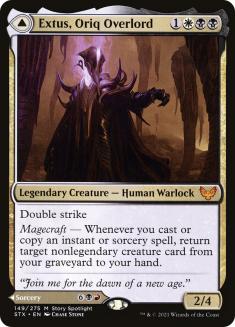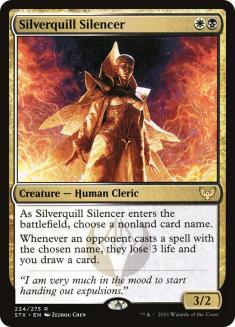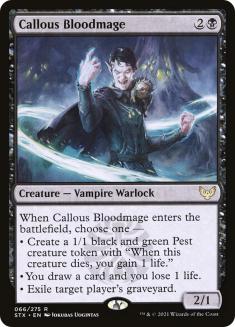Despite getting a Pathway of its own in Kaldheim, Rakdos has had a rough go of it this year in Standard. The sacrifice synergies that have powered the guild for much of the last two years have been weakened by the rotation of Priest of Forgotten Gods, Mayhem Devil, and other cards, and the combo of Cauldron Familiar and Witch’s Oven that looked to take its place was taken away via ban.
This has left Rakdos players scrambling to figure out how best to utilize the remaining tools in Claim the Firstborn and Village Rites, and the results have been less than stellar. Rakdos decks this past season often focused more on graveyard synergies than sacrifice ones, utilizing Tymaret Calls the Dead and escape cards to create a stream of hard-to-answer threats.
But these decks proved to be rather clunky, with few impactful plays before Turn 3, nor was their end-game powerful enough to compensate, especially in the face of other powerful end-game cards like Yorion, Sky Nomad and the Ultimatums. Rakdos became a midrange deck that would stumble too often to keep up against aggro, and wasn’t powerful enough to combat bigger decks. Only its best draws were competitive.
In a matchup like Dimir Rogues where they were enabling the graveyard for you, Rakdos excelled, but that wasn’t enough to maintain its status as a staple of the format, and the archetype has now all but fallen out of Standard entirely. Something is missing here.
Rakdos Needs Another Angle of Attack
When you look at the successful Rakdos Sacrifice decks from last year, as well as Jund Sacrifice in Historic, where it’s currently the best archetype in the metagame, you see not only more powerful decks, but more importantly more versatile ones. In Historic you see a Food engine, Collected Company, and/or Bolas’s Citadel supplementing the expected sacrifice creatures, and these provide either a powerful enough end-game to contend on that axis or the ability to end the game on the spot by assembling enough Mayhem Devils and sacrifice outlets.
In Standard, especially last summer, we saw Rakdos decks take an aggressive tack so that the recursive threats and synergies with Priest of Forgotten Gods offered resilience and reach, and so they weren’t relied on to win the game by themselves. It’s this gameplan that I want to bring back to Standard Rakdos decks, because Kroxa, Titan of Death’s Hunger, as powerful a card as it is, isn’t cutting it right now.
I particularly like getting aggressive in Sacrifice decks for a few reasons. One, Sacrifice decks like to amass large battlefields of creatures to take advantage of sacrifice synergies. This incentivizes a low curve so you can amass such a battlefield quickly, so you’re naturally building in the way an aggro deck would. Putting your opponent under pressure early also limits their options for interaction. They have to protect their life total to stay alive, and you can use that to your advantage by forcing them to kill otherwise irrelevant creatures, leaving your key synergy pieces alive to finish the game.
Second, playing an aggressive strategy with sacrifice synergies ensures that Claim the Firstborn is an excellent card. It’s the most powerful Threaten ever printed and a critical part of Sacrifice decks, but it can be a liability when you don’t have a sacrifice outlet around or against decks with low creature counts. In an aggressive shell, you mitigate that liability by using it to give a key creature haste or to steal a blocker and end the game on the spot. This is the angle of attack Rakdos decks have been missing.
Awaken the Blood Avatar may allow Rakdos decks diversify their gameplan enough to succeed. It may be the reverse side of the card, but it’s the more exciting side by quite a bit. That doesn’t mean Extus is irrelevant, especially with splashes so easily enabled by Fabled Passage and Pathways, but I’ll be focusing on Awaken.
The first step in evaluating Awaken the Blood Avatar is to figure out how many creatures we need to sacrifice in order to consistently have an above-rate card. At eight mana it would be unplayable, and at six mana it’s still not exciting. It’s when you sacrifice two creatures to reduce the cost to four that you get something exciting. Four mana for what is effectively a 6/6 with haste and an Edict on your opponent is a great curve-topper for an aggro deck. Paying two mana is even better, but sacrificing three creatures to do so is a steep cost.
With that curve in mind, I’m going to treat Awaken as a four-mana play, which is convenient since Extus is one as well. And since it’s going to top my curve, I want to fill out the rest of the deck with mostly one- to three-mana creatures. Lastly, in order to have the creatures to sacrifice, I want cards that create multiple bodies. With these ideas in mind, here’s my starting point:
Creatures (27)
- 2 Rankle, Master of Pranks
- 4 Woe Strider
- 2 Serrated Scorpion
- 4 Whisper Squad
- 3 Skyclave Shade
- 4 Extus, Oriq Overlord
- 4 Silverquill Silencer
- 4 Callous Bloodmage
Lands (24)
Spells (9)

This list ended up with less red and more white than I either expected or intended, but it’s a spiritual successor to the Rakdos Sacrifice decks of last year. It doesn’t have as many one-drops, but with Savai Triome you can’t afford to play as many, and unfortunately there’s no good replacement for Gutterbones. Instead Whisper Squad returns because it’s the best early creature at generating bodies for Awaken the Blood Avatar. I also like Skyclave Shade much more in this kind of Rakdos deck than in the slower lists that we’ve seen recently, since those decks wanted to block a lot more than this one.
It may not be a great card for a Sacrifice deck, but it’s certainly a great card for an aggressive deck. Silverquill Silencer can do everything from punishing a key sweeper to making your opponent’s curve a bit more painful. Importantly, it’s a two-drop that you’re not upset to see Stomped, which is rare in today’s Standard. This deck isn’t all-in on sacrifice synergies so finding space for such an efficient creature is easy.
And the card advantage Silencer provides can play quite well with the cards we’re playing to enable Awaken the Blood Avatar. Every extra card Silencer draws and every extra body left around from a Woe Strider after you cast Village Rites or trade with a removal spell leaves you slightly ahead, so despite being an aggro deck, you have a built-in resilience to removal-heavy strategies.
Woe Strider has been a staple in Standard since it was printed, but this deck is interested in even more creatures of that ilk, so the newly previewed Callous Bloodmage earns a spot here. Most of the time you’ll choose to create a token, but if you’re digging for removal or a key land drop, then simply drawing a card is an attractive option. And the last option will come up often enough against Dimir Rogues and escape cards that you’ll be happy it’s there. But most importantly, having eight three-drops that create two bodies ensures that you’ll have Awaken the Blood Avatar available on Turn 4 should you want it.
It’s not my main focus, even in a deck that can readily cast it, but Extus has some nice functionality here. Between Claim the Firstborn and Village Rites, you have plenty of cheap spells to try to set up a turn where you immediately get value, and both Silverquill Silencer and Callous Bloodmage are great creatures to return. Notably, since the magecraft trigger won’t go on the stack until after you pay all the costs for the spell, you can target a creature you just sacrificed to Village Rites or Awaken the Blood Avatar with the ensuing trigger from Extus.
Extus builds even more late-game power into the deck for effectively no cost. This list can easily shift into a more controlling gameplan against opposing creature decks, even without the power of Mayhem Devil. Extus is also a serviceable body for games where you’re curving out but don’t have the bodies you need to effectively reduce the cost of Awaken.
One thing I’m worried about is if this deck’s curve is low enough to consistently get ahead on the battlefield, but there aren’t other good options for cheap creatures in Rakdos right now unless you want to utilize your graveyard to make Mire Triton playable. This list has even more versatility with all the built-in card advantage, so we’ll have to content ourselves with that and the curve we have. To get more cheap creatures we’ll have to dip into a larger card pool.
Awaken the Blood Avatar in Pioneer?
Creatures (29)
- 4 Bloodsoaked Champion
- 2 Scrapheap Scrounger
- 4 Stitcher's Supplier
- 4 Priest of Forgotten Gods
- 4 Mayhem Devil
- 4 Cauldron Familiar
- 4 Woe Strider
- 3 Extus, Oriq Overlord
Lands (23)
Spells (8)

Normally I’d look to explore the archetype in Historic before Pioneer, and certainly something could work there, but I’d rather not walk headfirst into a metagame of Grafdigger’s Cages and Yasharn, Implacable Earths if I don’t have to. Once that metagame adjusts to the dominance of Jund Food and other Sacrifice variants and the hate dies down, I’ll be more interested in exploring this archetype in Historic.
Jund Sacrifice decks are making their way into Pioneer at this point, but the hate for them isn’t at nearly the same level. Now we get to explore the card in a shell with plenty of quality cheap creatures, most notably Bloodsoaked Champion to push the aggressive strategy. There’s also the dynamic duo of Witch’s Oven and Cauldron Familiar, which give this deck plenty of reach alongside Mayhem Devil and Awaken.
Mutavault is among the best cards in Pioneer and pulls double-duty here as both a great creature-land for an aggressive deck and a way to cast Awaken on Turn 3 with just two other creatures on the battlefield. Note that you can also do this with Claim the Firstborn on an opposing creature to get the third body to sacrifice, but in racing matchups like Lotus Field Combo you may not have a target for Claim, and casting Awaken as early as possible is very important when racing.
I’d love to have some Pathways in the manabase so Extus can once again come along for free, but with Dragonskull Summit in the deck, you need basic lands to curve out consistently. If you play Fabled Passage over Summit, which is perfectly reasonable in a deck with Mayhem Devil and escape cards, you could fit two or three Pathways into the deck over basic lands, but I think Fabled Passage will disrupt your curve by entering the battlefield tapped more often than Summit, so I’m going with the checkland.
Both of these decks have the ability to end games quickly with a traditional curve of aggressive creatures, while also being able to grind value in the face of opposing removal or another aggro deck. It’s this versatility that I’m trying to harness, so that your opponents can’t simply play to stop the sacrifice synergies and shut down your entire deck. Nor are you crippled by a sweeper or stopped in the red zone by large creatures like Lovestruck Beast. There really isn’t an obvious way to attack each deck, even if there are cards that are problematic.
How much removal do your opponents want in against these decks? Is graveyard hate worthwhile? How much can I rely on blockers in the face of Claim the Firstborn? These are difficult questions with no definitive answers, and it’s always good to force your opponent to make these kinds of decisions. Doing so has been the unsung key to the success of Rakdos Sacrifice decks in the past, and when it stopped being true, Rakdos decks stopped having success.
With Awaken the Blood Avatar to once again push the deck into a well-defined, aggressive gameplan, look for the guild to experience a resurgence, even if it’s not represented by one of the schools in Strixhaven.




